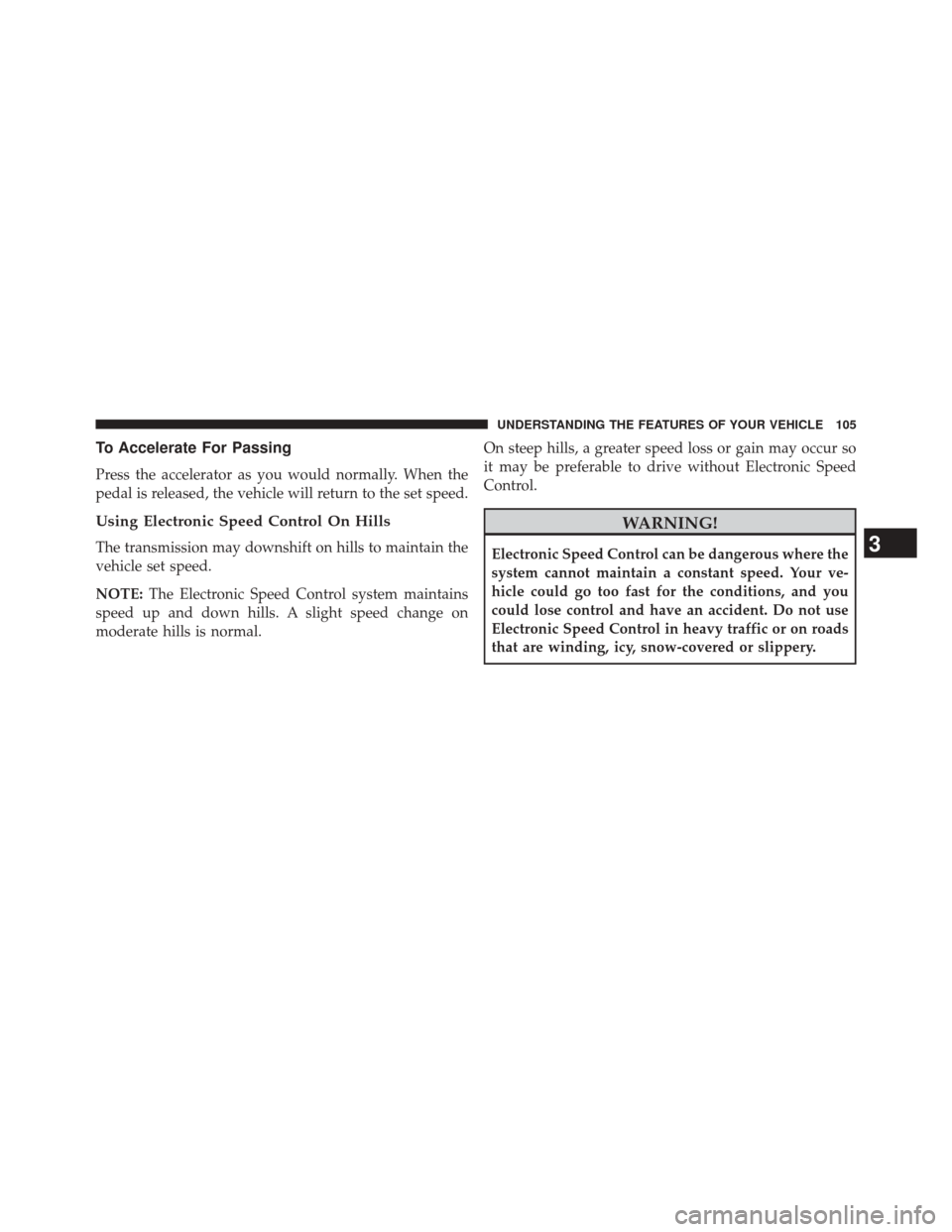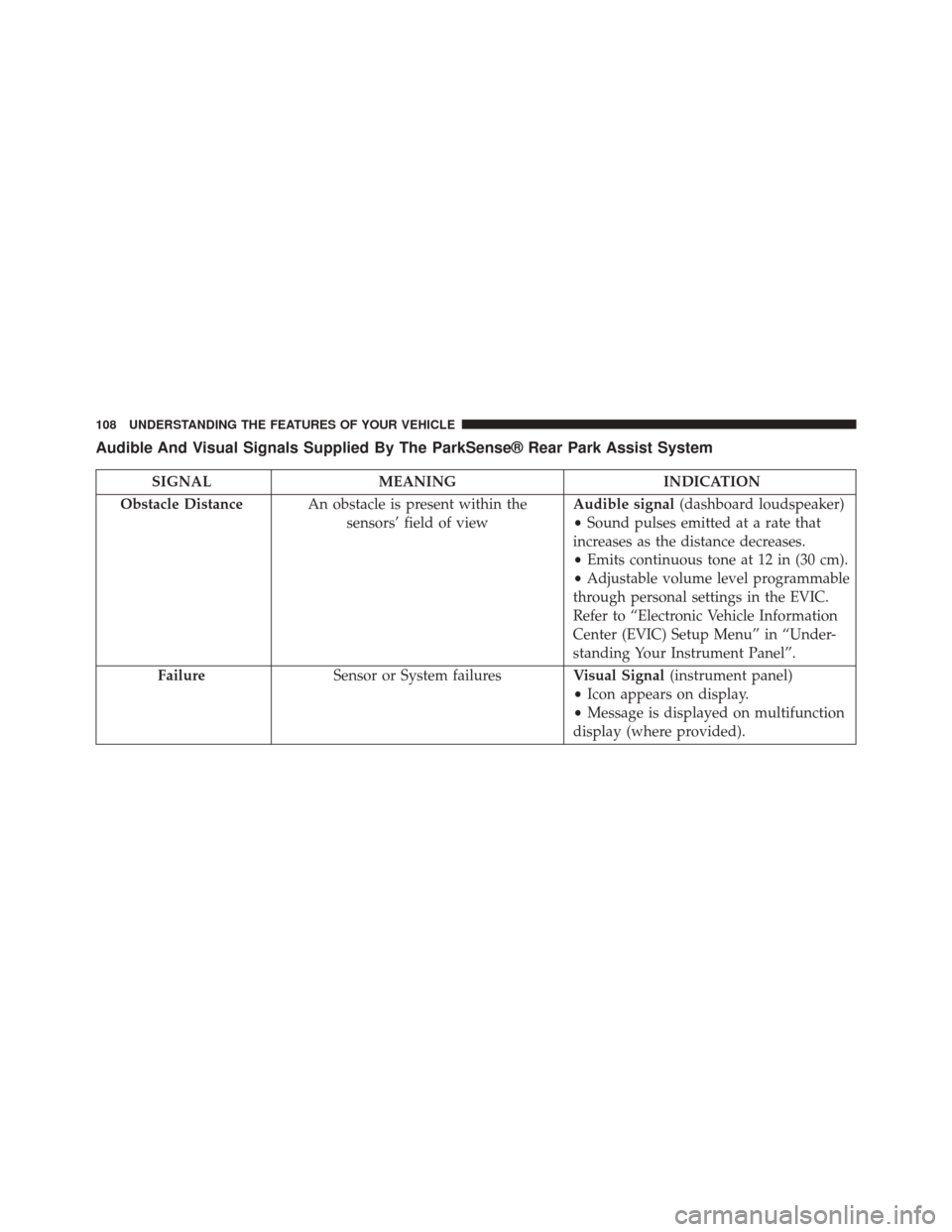Ram ProMaster 2014 Owner's Manual
Manufacturer: RAM, Model Year: 2014, Model line: ProMaster, Model: Ram ProMaster 2014Pages: 410, PDF Size: 2.83 MB
Page 101 of 410

Low Speed
Push the lever downward to the second detent. The
wipers will operate at low speed.
High Speed
Push the lever downward to the third detent. The wipers
will operate at high speed.
Mist Feature
Use the Mist feature when weather conditions make
occasional usage of the wipers necessary. Push the lever
upward to the Mist position and release for a single
wiping cycle.
NOTE:The mist feature does not activate the washer
pump; therefore, no washer fluid will be sprayed on the
windshield. The wash function must be used in order to
spray the windshield with washer fluid.
Windshield Washer Operation
To use the washer, pull the windshield wiper/washer
lever toward the steering wheel to activate the washers.
The wipers will activate automatically for three cycles
after the lever is released. and then resume the intermit-
tent interval previously selected.
If the lever is pulled while in the off position, the wipers
will operate for three cycles, then turn off.
WARNING!
Sudden loss of visibility through the windshield
could lead to a collision. You might not see other
vehicles or other obstacles. To avoid sudden icing of
the windshield during freezing weather, warm the
windshield with the defroster before and during
windshield washer use.
3
UNDERSTANDING THE FEATURES OF YOUR VEHICLE 99
Page 102 of 410

TELESCOPING STEERING COLUMN
This feature allows you to lengthen or shorten the
steering column. The telescoping control handle is lo-
cated below the steering wheel at the end of the steering
column.To unlock the steering column, pull the control handle
up. To lengthen or shorten the steering column, pull the
steering wheel outward or push it inward as desired. To
lock the steering column in position, push the control
handle down until fully engaged.
WARNING!
Do not adjust the steering column while driving.
Adjusting the steering column while driving or driv-
ing with the steering column unlocked, could cause
the driver to lose control of the vehicle. Failure to
follow this warning may result in serious injury or
death.
Telescoping Control Handle
100 UNDERSTANDING THE FEATURES OF YOUR VEHICLE
Page 103 of 410

ELECTRONIC SPEED CONTROL
When engaged, the Electronic Speed Control takes over
accelerator operations at speeds greater than 25 mph
(40 km/h) up to the maximum speed of 100 mph
(160 km/h).
The Electronic Speed Control Lever is located on the left
side of the steering column.
Electronic Speed Control Lever
3
UNDERSTANDING THE FEATURES OF YOUR VEHICLE 101
Page 104 of 410

NOTE:In order to ensure proper operation, the Elec-
tronic Speed Control System has been designed to shut
down if multiple Speed Control functions are operated at
the same time. If this occurs, the Electronic Speed Control
System can be reactivated by rotating the Electronic
Speed Control ON/OFF center ring and resetting the
desired vehicle set speed.
To Activate
Rotate the center ring upward on the electronic speed
control lever to turn the system ON. The Cruise Indicator
Light in the instrument cluster will illuminate. To turn
the system OFF, rotate the center ring upward a second
time. The Cruise Indicator Light will turn off. The system
should be turned off when not in use.
WARNING!
Leaving the Electronic Speed Control system on
when not in use is dangerous. You could accidentally
set the system or cause it to go faster than you want.
You could lose control and have an accident. Always
leave the system OFF when you are not using it.
To Set A Desired Speed
Turn the Electronic Speed Control ON. When the vehicle
has reached the desired speed, move the electronic speed
control lever upward SET(+) and release. Release the
accelerator and the vehicle will operate at the selected
speed.
NOTE: The vehicle should be traveling at a steady speed
and on level ground before moving the electronic speed
control lever upward SET(+).
102 UNDERSTANDING THE FEATURES OF YOUR VEHICLE
Page 105 of 410

To Deactivate
A soft tap on the brake pedal, pushing the RES button, or
normal brake pressure while slowing the vehicle will
deactivate Electronic Speed Control without erasing the
set speed memory. Rotating the center ring upward to
turn the system OFF or turning the ignition switch OFF
erases the set speed memory.
To Resume Speed
To resume a previously set speed, push the RES button
and release. Resume can be used at any speed above
25 mph (40 km/h) up to the maximum speed of 100 mph
(160 km/h).
To Vary The Speed Setting
To Increase Speed
When the Electronic Speed Control is set, you can in-
crease speed by tapping the Speed Control lever up (+).
The speed increment shown is dependant on the speed of
U.S. (mph) or Metric (km/h) units:
U.S. Speed (mph)
•Tapping the Speed Control lever up (+) once will result
in a 1 mph increase in set speed. Each subsequent tap
of the lever results in an increase of 1 mph.
• If the lever is continually help up, the set speed will
continue to increase until the lever is released, then the
new set speed will be established.
3
UNDERSTANDING THE FEATURES OF YOUR VEHICLE 103
Page 106 of 410

Metric Speed (km/h)
•Tapping the Speed Control lever up (+) once will result
in a 2 km/h increase in set speed. Each subsequent tap
of the lever results in an increase of 2 km/h.
• If the lever is continually help up, the set speed
will continue to increase until the lever is released,
then the new set speed will be established.
To Decrease Speed
When the Electronic Speed Control is set, you can
decrease speed by tapping the Speed Control lever
down (-). The speed decrement shown is dependant on the speed
of U.S. (mph) or Metric (km/h) units:
U.S. Speed (mph)
•
Tapping the Speed Control lever down (-) once will
result in a 1 mph decrease in set speed. Each subse-
quent tap of the lever results in a decrease of 1 mph.
• If the lever is continually held down, the set speed will
continue to decrease until the lever is released, then
the new set speed will be established.
Metric Speed (km/h)
• Tapping the Speed Control lever down (-) once will
result in a 2 km/h decrease in set speed. Each subse-
quent tap of the lever results in a decrease of 2 km/h.
• If the lever is continually held down, the set speed will
continue to decrease until the lever is released, then
the new set speed will be established.
104 UNDERSTANDING THE FEATURES OF YOUR VEHICLE
Page 107 of 410

To Accelerate For Passing
Press the accelerator as you would normally. When the
pedal is released, the vehicle will return to the set speed.
Using Electronic Speed Control On Hills
The transmission may downshift on hills to maintain the
vehicle set speed.
NOTE:The Electronic Speed Control system maintains
speed up and down hills. A slight speed change on
moderate hills is normal. On steep hills, a greater speed loss or gain may occur so
it may be preferable to drive without Electronic Speed
Control.
WARNING!
Electronic Speed Control can be dangerous where the
system cannot maintain a constant speed. Your ve-
hicle could go too fast for the conditions, and you
could lose control and have an accident. Do not use
Electronic Speed Control in heavy traffic or on roads
that are winding, icy, snow-covered or slippery.3
UNDERSTANDING THE FEATURES OF YOUR VEHICLE 105
Page 108 of 410

PARKSENSE® REAR PARK ASSIST —
IF EQUIPPED
The ParkSense® Rear Park Assist system provides an
audible indication of the distance between the rear
fascia/bumper and a detected obstacle when backing up,
e.g. during a parking maneuver. Refer to ParkSense®
System Usage Precautions for limitations of this system
and recommendations.
The ParkSense® Rear Park Assist is automatically acti-
vated when the transmission is placed into REVERSE. As
the distance from an obstacle behind the vehicle de-
creases, the audible alert becomes more frequent.Interaction With Trailer Towing
The Rear Park Assist system is automatically deactivated
when a trailer is hitched to the vehicle. The system will be
automatically activated as soon as the trailer is removed.
ParkSense® Rear Park Assist Sensors
The four ParkSense® Rear Park Assist sensors, located in
the rear fascia/bumper, monitor the area behind the
vehicle that is within the sensors’ field of view. The
sensors can detect obstacles, in the horizontal direction,
from approximately 12 in (30 cm) up to 55 in (140 cm)
from the center of the rear fascia/bumper and up to 24 in
(60 cm) from the corners of the rear fascia/bumper,
depending on the location, type and orientation of the
obstacle.
106 UNDERSTANDING THE FEATURES OF YOUR VEHICLE
Page 109 of 410

If several obstacles are detected, the ParkSense® Rear
Park Assist system indicates the nearest obstacle.
The minimum height of a detectable obstacle corresponds
to the maximum height of an obstacle that would clear the
underside of the car during the parking maneuver.
ParkSense® Rear Park Assist Alerts
If an obstacle is behind the vehicle when REVERSE gear
is engaged, an audible alert is activated.
The tones emitted by the loudspeaker inform the driver
that the vehicle is approaching an obstacle. The pauses
between the tones are directly proportional to the dis-
tance from the obstacle. Pulses emitted in quick succes-
sion indicate the presence of a very close obstacle. A
continuous tone indicates that the obstacle is less than
12 in (30 cm) away.
Rear Park Assist Sensors Location
3
UNDERSTANDING THE FEATURES OF YOUR VEHICLE 107
Page 110 of 410

Audible And Visual Signals Supplied By The ParkSense® Rear Park Assist System
SIGNALMEANING INDICATION
Obstacle Distance An obstacle is present within the
sensors’ field of view Audible signal
(dashboard loudspeaker)
• Sound pulses emitted at a rate that
increases as the distance decreases.
• Emits continuous tone at 12 in (30 cm).
• Adjustable volume level programmable
through personal settings in the EVIC.
Refer to “Electronic Vehicle Information
Center (EVIC) Setup Menu” in “Under-
standing Your Instrument Panel”.
Failure Sensor or System failures Visual Signal(instrument panel)
• Icon appears on display.
• Message is displayed on multifunction
display (where provided).
108 UNDERSTANDING THE FEATURES OF YOUR VEHICLE